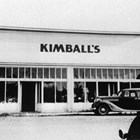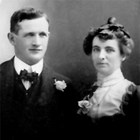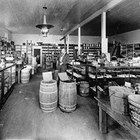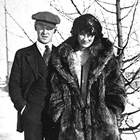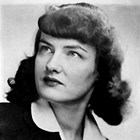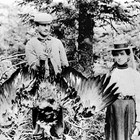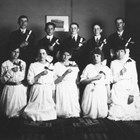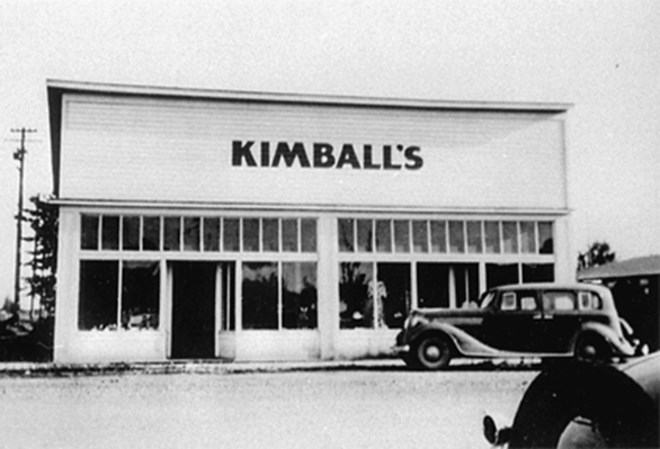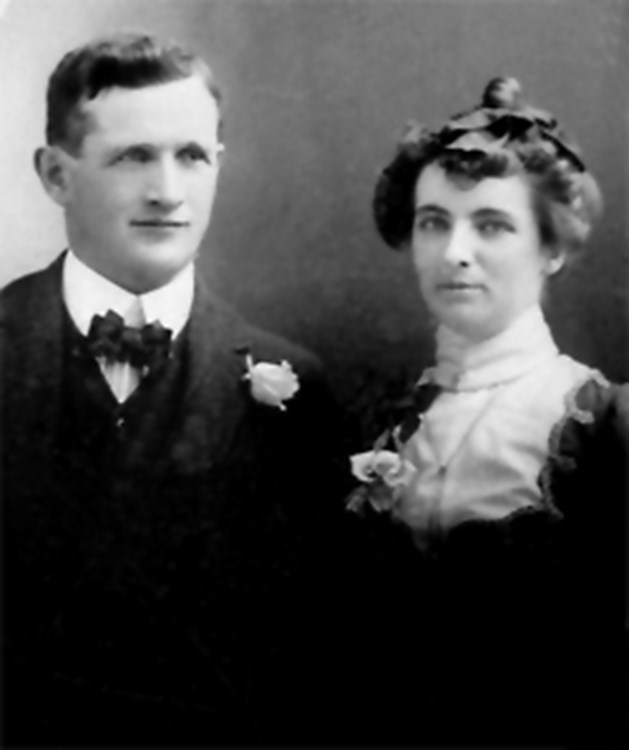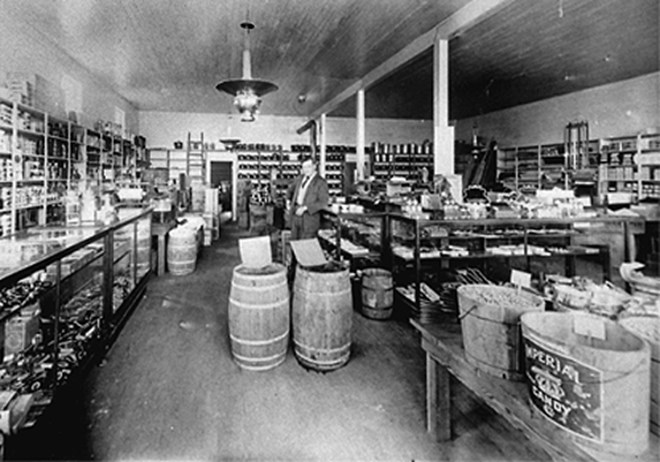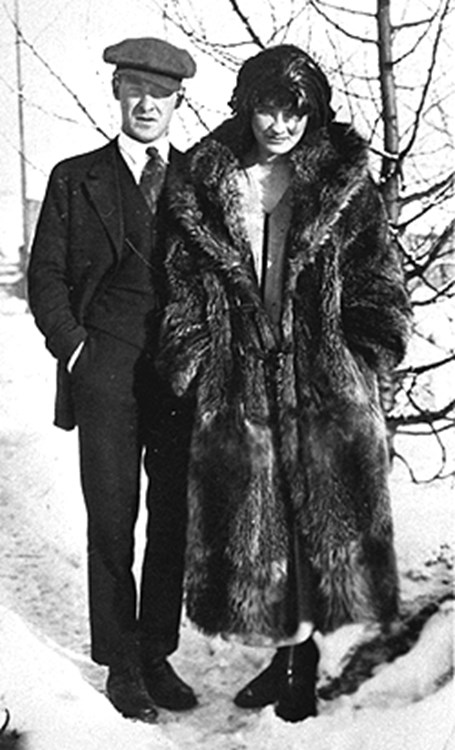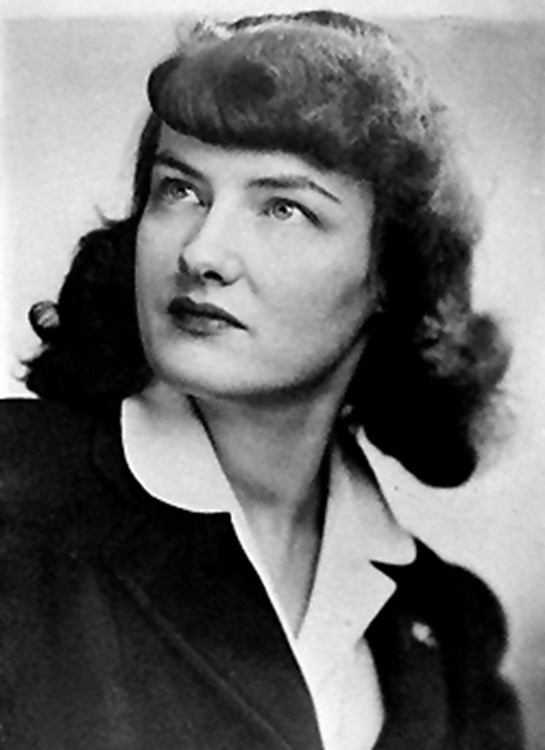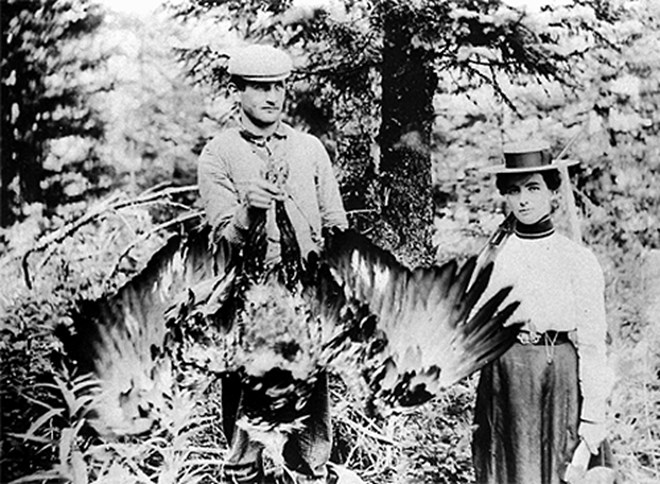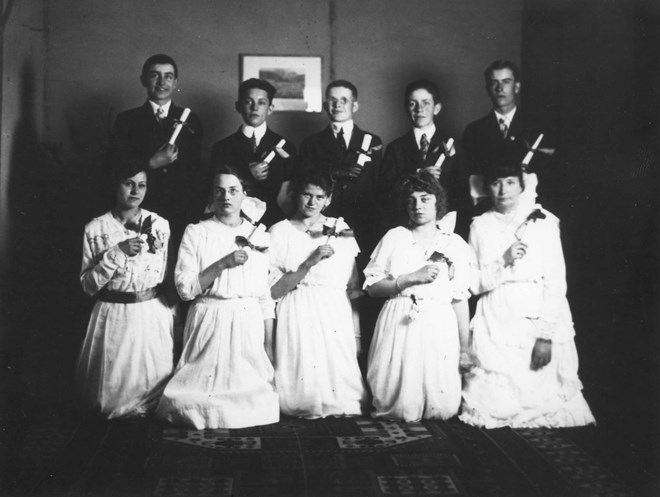Kimball, Irving L. "Irv" or "I.R."
1869-1921 | Merchant and trader
Irving L. Kimball was one of Anchorage’s well-known pioneer merchants during the beginnings of the city’s existence. In 1915, the family business, Kimball’s Dry Goods store, was opened on the southwest corner of Fifth Avenue and E Street. After his death in 1921, Kimball’s widow, Della, daughter, Decema, and other family members continued to operate the store until 2002. Through the charm of the Kobuk Coffee Company, this National Register of Historic Places designated landmark situated in the heart of downtown Anchorage, continues in operation. The owners have consciously sought to preserve the building’s historic character of an early twentieth century frontier commercial building.
Early Years
Irving Leonard Kimball, known as “Irv” or “I.R.,” was among Anchorage’s first merchants and possessed an adventurous spirit. He was born in the community of Eckland, near the town of Osceola, Pennsylvania on December 20, 1869, the second of six children of Leverne Leonard Kimball and Julia Honore O’Connell Kimball. His father, Leverne, was born in Pennsylvania and was a farmer. His mother, Julia Honore O’Connell Kimball, an Irish immigrant, was born in Abbyfeale, Limerick, Ireland, on November 1, 1848. Young Kimball grew up with his family in Osceola, Tioga County, Pennsylvania.1
Kimball moved to Oregon as a young man. By age thirty, he was living in Portland, Oregon, where he worked as a clerk.2 In 1897, he signed on as a ship’s storekeeper on an Arctic trading vessel on the western Alaska coast. In 1900, he witnessed the rush of people to Nome, where more than twenty thousand men and women clogged the town’s streets or lived in hundreds of tents that extended for fifteen miles along the beach, working the “golden sands,” which contained gold-bearing sand.3 Although undoubtedly tempted, Kimball stayed with the ship that was transporting gold seekers and freight. After successful trading ventures in Nome and the Arctic, Kimball’s vessel was caught in ice floes off Point Barrow and wrecked. He was stranded for two years at Barrow, where he stayed as a trader, then returned to Nome, and shipped back on the Dora to Portland.4
In 1902,5 Kimball married Della Carpenter, in Forest Grove, Washington County, Oregon. Della Carpenter was born on February 8, 1880, in Mason, Iowa. She spent her childhood on her family’s farm in Iowa. She left with her family to move westward in a covered wagon. They entered the Cherokee Strip (a formerly disputed section of land in eastern Indian Territory that is now part of Kansas) and then settled in Glenwood, Oregon. She became engaged to Kimball in 1898, before he left Portland to travel on a trading ship to the western Alaska coast, and did not hear from him until four years later, after he had been stranded in Barrow. Soon after the couple was married, they left for Kodiak, where they spent the summer of 1902.6
General Mercantile Stores (Latouche, Resurrection Bay, and Anchorage)
In the fall of 1902, Kimball and his wife, Della, returned to the Alaska mainland to establish a trading post at Resurrection Bay, the coastal terminus and tidewater port of the proposed Alaska Central Railroad. Kimball’s trading post was one of the first businesses in the community which within a year became designated as the town of Seward. Although construction started on the Alaska Central Railroad in 1903, the project went bankrupt in 1909,7 and so Kimball and his wife, Della, left and moved to Latouche Island in Prince William Sound, the site of several important copper mines.8
In Latouche, Kimball operated a general store located halfway down from the copper mines, from 1907 to 1915. His store was probably located on Horseshoe Bay, the site of a small town that was built by the Reynolds-Alaska Development Company near the Bonanza mine.9 The family’s business suffered in Latouche due to a disastrous 1913 store fire and increasing competition from the Latouche Mining Copper Company commissary located about a half mile north of the mine.10 When American copper began to be underpriced by the Anaconda interests in South America, hard times began for the Guggenheim-Kennecott mines at Latouche and Kennecott, and the family was ready to move again.11
On March 12, 1914, Congress agreed to fund the construction and operation of the Alaska Railroad from Seward to Fairbanks. After starting stores in Seward and Latouche, Kimball brought his family to the “Tent City” of Ship Creek, the site selected in 1915 as the field construction headquarters for the Alaska Railroad. The family lived in “Tent City” until the original Anchorage townsite auction was held on July 10, 1915. Kimball purchased a parcel of land, known as Lot 1, Block 51, for $500, in the southwest corner of Fifth Avenue and E Street (500 and 504 West Fifth Avenue), and built Kimball’s Dry Goods. While the store was being constructed in August and September of 1915, the family lived in a tent in the back of their lot. After the building was completed in September 1915, they moved into the living quarters located in the rear of the store.12
In November 1915, Kimball’s Dry Goods opened and the Kimballs sold general merchandise, hardware, and groceries. The store was one of the few retail establishments on Fifth Avenue in the early years, as most commercial outlets were built on Fourth Avenue.
Kimball was actively involved in civic affairs for the new Anchorage townsite. In 1918, he was one of twenty-eight property owners who were nominated as candidates for seven places on the Anchorage Advisory Board. This board was created to advise the Alaskan Engineering Commission about the administration of the Anchorage townsite. After the voting was held on September 16, 1918, he polled 54 out of the 145 votes cast and, lost, finishing in ninth place.13 That month, he was selected to serve as one of the “leading merchants of Anchorage” on the Fair Price Committee, which was established to set fair prices for food staples under the regulations of the U.S. Food Administration during World War I.14 Della Carpenter Kimball was one of the organizers of the Anchorage Woman’s Club and was actively involved in the community’s civic life for many years.15
Kimball became one of the Anchorage’s larger property owners. In 1919, he purchased eight tracts of land at a public auction held at the office of the Anchorage townsite on August 20. The lots were bought at prices ranging from $50 to $70 per lot.16
Irving Kimball continued to operate the store until about August 1921. In August and September 1921, he was treated for a prolonged illness, encephalitis lethargica. Between 1915 and 1926, an epidemic of encephalitis lethargica spread around the world. He died at the Alaska Railroad Hospital on September 7, 1921.17 He was survived by his widow, Della Carpenter Kimball, and two daughters, Vera18 and Decema.19 In 1958, Della Carpenter Kimball died. The couple was interred at Anchorage Memorial Park Cemetery.20
Legacy
After Kimball’s death, his widow, Della Carpenter Kimball, continued to operate Kimball’s Dry Goods by herself, rebuilding it twice. In 1935, Kimball’s discontinued selling groceries, but continued to sell general merchandise and hardware as lines of business. Her daughter, Decema Kimball Andresen, joined her in partnership in 1938. In 1950, Decema, now a young widow with two sons, Carl and Alfred, re-joined her mother in operating the store. In 1958, after the death of Della Carpenter Kimball, the store was divided into two portions, with the dry goods business continued in one half, while a paint store was developed in the other.21 In the 1990s, Anchorageites saw both Decema and her older sister, Vera, assisting customers.
Decema Kimball Andresen Slawson operated the store until she died in 2002 at the age of ninety-five. Decema Kimball Andresen Slawson (June 25, 1906-February 4, 2002) is buried in Angelus Memorial Park Cemetery, Anchorage.22
From 1915 to 2002, Kimball’s Dry Goods was the oldest continuously operating business in Anchorage. In its place, Kobuk Coffee Company bought the building and expanded its operations.23 The Kimball Building is on the National Register of Historic Places and is protected by the Anchorage City Charter. The building is the only remaining commercial building located in its original place from the original Anchorage townsite of 1915.
Endnotes
1. Irving Kimball, Pennsylvania 1880 Census, Osceola, Tioga County, Pennsylvania, ED 162, page 2, National Archives Microfilm Publication M593, Ninth Census of the United States, 1870, Roll 1457, 1870 United States Federal Census [database on-line], http://ancestry.com (accessed November 4, 2015).
2. Irving Kimball, Oregon 1900 Census, Portland, Ward 5, Multnomah County, Oregon, ED 58, page 7, National Archives Microfilm Publication T623, Twelfth Census of the United States, 1900, Roll 1350, 1900 United States Federal Census [database on-line], http://ancestry.com (accessed November 4, 2015).
3. Phyllis Carlson, Mike Kennedy, and Cliff Cernick, Anchorage: The Way It Was (Anchorage: Historic Landmark Preservation Commission, Municipality of Anchorage, 1981): 14; Claus-M. Naske and Herman E. Slotnick, Alaska: A History, Third Edition (Norman: University of Oklahoma Press, 2011), 130-131; and “Nome’s Beaches Yield Gold,” Northwest and the Arctic, 1897-1920, Alaska History and Cultural Studies, Alaska Humanities Forum, http://www.akhistorycourse.org/articles/article.php?artID=66 (accessed November 3, 2015).
4. Rolfe Buzzell, “Kimball’s Store,” 500 and 504 West 5th Avenue, Anchorage, Alaska, National Register of Historic Places Inventory-Nomination Form, AHRS Site No. ANC-269, June 25, 1986, National Register of Historic Places, http://focus.nps.gov/pdfhost/docs/nrhp/text/86001901.pdf (accessed November 4, 2015), 3; and Phyllis Carlson, Mike Kennedy, and Cliff Cernick, Anchorage: The Way It Was: 14.
5. Irving L. Kimball, 1910 Alaska Census, Latouche Island, Prince William Sound, Alaska, Second District, ED 3, stamped page 83, National Archives Microfilm Publication T624, Thirteenth Census of the United States, 1910, Roll 1750, 1910 United States Federal Census [database on-line], http://ancestry.com (accessed November 4, 2015).
6. “Della Kimball Started Store in Tent in 1915,” Anchorage Daily Times, February 26, 1958, 15, in File: Kimball, Irving, Bagoy Pioneer Family Files (2004.11), Box 4, Atwood Resource Center, Anchorage Museum at Rasmuson Center, Anchorage, AK.
7. William H. Wilson, The Alaska Railroad in the Age of Steam, 1914-1945 (Boulder, CO: Pruett Publishing Company, 1977), 6-7; and Mary J. Barry, Seward, Alaska: A History of the Gateway City, Part I: Prehistory to 1914 (Anchorage: M.J.P. Barry, 1986), 52-77.
8. Rolfe Buzzell, “Kimball’s Store,” 500 and 504 West 5th Avenue, Anchorage, Alaska, National Register of Historic Places Inventory-Nomination Form, AHRS Site No. ANC-269, June 25, 1986; National Register of Historic Places, 3.
9. U.S. Grant and D.F. Higgins, Reconnaissance of the Geology and Mineral Resources of Prince William Sound, Alaska, U.S. Geological Survey Bulletin No. 443 (Washington, DC: Government Printing Office, 1910): 63-67; http://pubs.usgs.gov/bul/0443/report.pdf (accessed November 4, 2015).
10. Decema Kimball Andresen, Memories of Latouche (Anchorage: Publications Consultants, 1997), 33-39.
11. Michael Carberry and Donna Lane, Patterns of the Past: An Inventory of Anchorage’s Historic Resources (Anchorage: Community Planning Department, Municipality of Anchorage, 1986): 71.
12. Rolfe Buzzell, “Kimball’s Store,” 500 and 504 West 5th Avenue, Anchorage, Alaska, National Register of Historic Places Inventory-Nomination Form, AHRS Site No. ANC-269, June 25, 1986, National Register of Historic Places, 3; and Rae Arno, Anchorage Place Names: The Who and Why of Streets, Parks, and Places (Anchorage: Todd Communications, 2008), 42.
13. “Candidates Announced for Seven Places on City Advisory Board,” Alaska Railroad Record, v. 2, no. 43, September 3, 1918, 340, “Voting Place for Advisory Council Elections Monday will be at Fire Hall,” Alaska Railroad Record, v. 2, no. 44, September 10, 1918, 348, and “Seven Candidates are Elected to Membership on Anchorage Advisory Board,” Alaska Railroad Record, v. 2, no. 45, September 17, 1918, 353, Alaska State Library (Juneau) Ebrary, http://site.ebrary.com/lib/akstatedash/detail.action?docID=80153197 (accessed November 3, 2015).
14. “Leading Merchants of Anchorage become Members of Fair Price Committee,” Alaska Railroad Record, v. 2, no. 45, September 17, 1918, 357; Alaska State Library (Juneau) Ebrary.
15. John P. Bagoy, Legends & Legacies, Anchorage, 1910-1935 (Anchorage: Publications Consultants, 2001), 78.
16. “Sale of Anchorage Property brings Nine Hundred and Forty Dollars,” Alaska Railroad Record, August 26, 1919, 335, Alaska State Library (Juneau), Ebrary.
17. Irving Kimball, Standard Certificate of Death, No. 0694, Filed: September 10, 1921 [date of death: September 7, 1921], Office of the Registrar of Vital Statistics, Territory of Alaska, Juneau, AK. This is a copy of the original certificate on file in the Bureau of Vital Statistics, Department of Health and Social Services, Juneau, AK.
18. As reported in the Valdez Prospector (Valdez, AK) on April 18, 1903, the Kimball’s oldest daughter, Vera Kimball Castles, was “the first white child born in this section” [i.e., on the western side of the Kenai Peninsula] of Alaska. Vera left Alaska sometime after her father died in 1921 and moved to New York City. She was at the time of her mother’s death in 1958, “reported to be the editor of the Chemist’s Magazine and secretary of the American Institute of Chemists.” Mary J. Barry, Seward, Alaska: A History of the Gateway City, Part I: Prehistory to 1914, 36, and 47-48.
19. “I.R. Kimball Dead,” Anchorage Daily Times, September 8, 1921, 5, in File: Kimball, Irving, Bagoy Family Pioneer Files (2004.11), Box .4, Atwood Resource Center, Anchorage Museum at Rasmuson Center, Anchorage, AK.
20. Entries for Irving Kimball and Della Carpenter Kimball, U.S., Find A Grave Index, 1600s-Current, http://ancestry.com (accessed November 4, 2015).
21. Michael Carberry and Donna Lane, Patterns of the Past: An Inventory of Anchorage’s Historic Resources: 72.
22. Entry for Decema Alaska Kimball Andresen Slawson, Find A Grave Memorial, http://www.findagrave.com/cgi-bin/fg.cgi?page=gr&GRid=29245434 (accessed November 3, 2015).
24. Richard Richtmyer, “Restoring Store – Kobuk Coffee Co. to Expand as Kimball’s Dry Goods Closes,” Anchorage Daily News, December 4, 2002, E-1.
Sources
This biographical sketch of Irving L. Kimball was originally published in John Bagoy’s Legends & Legacies, Anchorage, 1910-1935 (Anchorage: Publications Consultants, 2001), 77-78. See also the Irving and Della Kimball file, Bagoy Family Pioneer Files (2004.11), Box 4, Atwood Resource Center, Anchorage Museum at Rasmuson Center, Anchorage. AK. Note: updated, expanded, and revised by Bruce Parham, November 7, 2015.
Preferred citation: Bruce Parham, “Kimball, Irving L. ‘Irv’ or ‘I.R.’,” Cook Inlet Historical Society, Legends & Legacies, Anchorage, 1910-1940, http://www.alaskahistory.org.
Major support for Legends & Legacies, Anchorage, 1910-1940, provided by: Anchorage Museum at Rasmuson Center, Atwood Foundation, Cook Inlet Historical Society, and the Rasmuson Foundation. This educational resource is provided by the Cook Inlet Historical Society, a 501 (c) (3) tax-exempt association. Contact us at the Cook Inlet Historical Society, by mail at Cook Inlet Historical Society, Anchorage Museum at Rasmuson Center, 625 C Street, Anchorage, AK 99501 or through the Cook Inlet Historical Society website, www.cookinlethistory.org.
